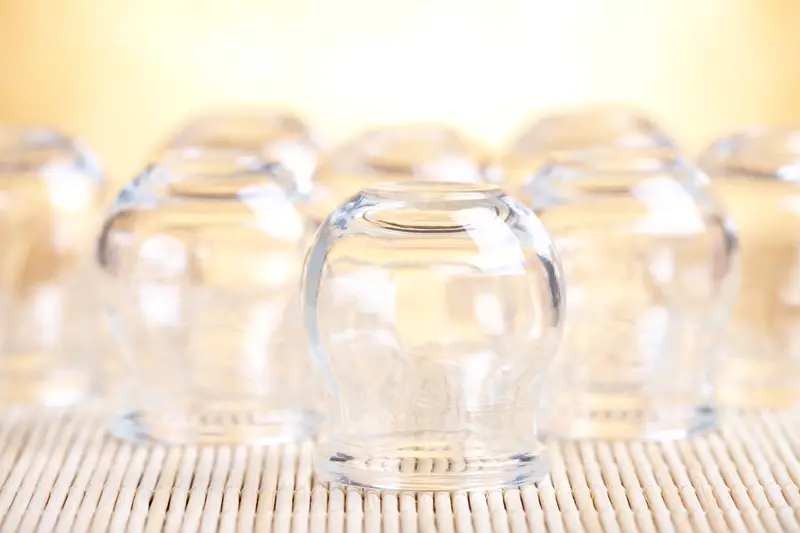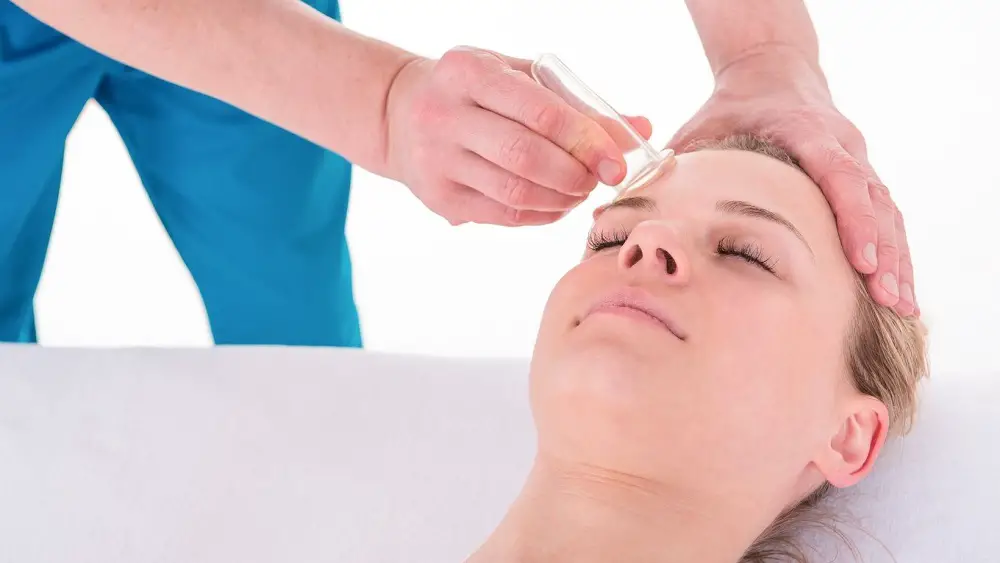Double vision is a symptom associated with damage to the cranial nerves that are responsible for extraocular muscle function. In Chinese medicine, the eyes are the functional sphere of the Liver, and it reflects the state of all the organisms. The treatment for eye disorders includes the stimulation of some acupressure points for double vision that we’ll feature in this article and that anyone can use at home.
The symptom that an object looks like two or double is called “diplopia”. It is a symptom that interferes with one’s personal life. People who suffer from it can fall and have a fracture or sprain because their perspective becomes misaligned and mismeasured in relation to steps due to the double appearance that this symptom implies.
It can also be caused by overwork, stress, chronic fatigue, sleep disorders, etc. Concomitantly, systemic symptoms such as stiff neck and shoulders, headache, nausea, and general malaise may occur, and long-lasting symptoms may lead to depression and insomnia.
Diplopia is not pathological and develops temporarily due to overuse of the eyes. It may heal spontaneously, but if there is a sudden worsening or prolongation of this symptom, then more serious diseases involving the brain and nervous system can be the hidden cause underlying it.
Before undergoing acupuncture and moxibustion, consult a specialized medical institution where you can receive acupuncture and moxibustion treatments without worrying about tumors or aneurysms.
Does Acupuncture Help Double Vision?

Yes. Some acupoints such as Qiuhou and Jingming are very effective in the treatment of double vision. As long as stimulated regularly over a long-term treatment course, they can help to recover the normality of eyesight.
According to Western medicine, health conditions that can cause double vision are:
- Abducens palsy
- Ophthalmoplegia
In TCM, however, this symptom is associated with Blood deficiency.
Acupuncture therapy is expected to open the meridians, relax muscles, and promote blood circulation around the eyes. Usually, local acupoints are selected along the meridians and based on syndrome differentiation.
Oriental medicine thinks that nerve palsy is caused by “poor blood flow around the eyeball”. Poor blood flow causes the nerves that move the eyeballs to become undernourished, damaging and paralyzing the nerves.
As you’ll see, most of the acupoints that we’ll feature here are located around the eyes and surrounding areas. The stimulation of all these points is to be done in a similar way. To stimulate your acupressure points for double vision, first, make sure you have spotted the right place, then apply gentle and firm pressure, moving your index or thumb in circular movements so as to exert a continuous stimulation for about a minute or two. You can repeat it from two to seven times on each side.
Can Acupuncture Heal Eyes?
Yes, acupuncture can heal many different eye conditions as long as it is done properly by a fully qualified practitioner with traditional training.
According to an article published on Healthcare Medicine Institute website, researchers at First People’s Hospital of Lanzhou in China have tested the effects of acupuncture and supplementation in patients diagnosed with ophthalmoplegia. Their findings, according to this article, were that acupuncture was effective in eliminating the symptoms, including double vision, and recovering the proper function of the optic nerve.
Ancient Wisdom Accuracy

Among traditional Chinese medicine practitioners, it’s well known that there are many acupuncture points to improve vision that can definitely solve a wide variety of dysfunctions that affect the eyes, including extraocular muscle palsy, cranial nerve palsy, etc. However, when it comes to clinical acupuncture, it is necessary to have a proper personal diagnosis from a qualified doctor in order to do the treatment.
The amazing thing about acupressure is that it doesn’t take a professional’s diagnosis to carry out the treatment, you can confidently do it by yourself at home, but there are some measures to observe if you want to make the most out of this tool.
One very important factor to consider if you really want your treatment to work for you is how often you stimulate your acupressure points for double vision. It must be done regularly in the beginning, preferably daily, until the symptoms subside. Once there is a considerable reduction in the symptoms, then you can change the frequency of the treatment and do it four or three times a week until there are no more symptoms left.
How Distal Acupressure Works
If you’re new to this practice, you may feel awkward seeing distal points, such as foot acupressure points for better eye vision, but this has a well-established logic in the TCM system. Since the meridians that carry Qi in the body are longitudinal and have a gradual flow intensity, the stimulation on one side affects the other end of the channel.
A study carried out on mice and published in the Hindawi journal of scientific findings showed a significant increase in blood flow in the eyes of the subjects after a foot acupuncture treatment. The increased blood flow was observed in both the blood vessels as well as in the tissues of the eyes.
This study can serve as a scientific explanation for the efficacy of distal stimulation in the elimination of symptoms such as double vision after stroke with acupuncture. In general, it is part of the protocol to use distal acupoints in most treatments, combined with local points.
Acupuncture Points To Treat Double Vision
For Medial rectus muscle paralysis
Acupoint: Bl-1 (Other Names: Urinary Bladder-1/Jing Ming/Bright Eyes)
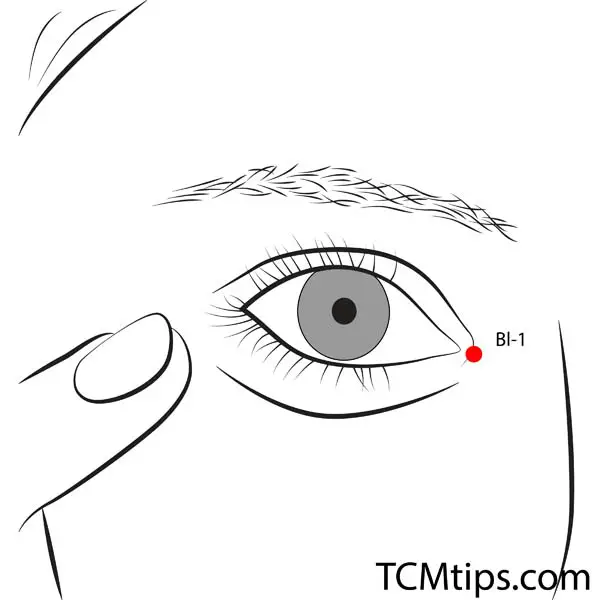
Bl-1 Jingming is located in the inner corner of both eyes. It’s a local acupoint that benefits the eyes, helps to reduce inflammation, and improves nerve function. It’s included in the treated acupressure points for cataracts.
Have a look at the other uses of Jingming in our article about acupressure points for autoimmune inflammation.
Acupoint: Bl-2 (Other Names: Urinary Bladder-2/Zan Zhu/Gathered Bamboo)
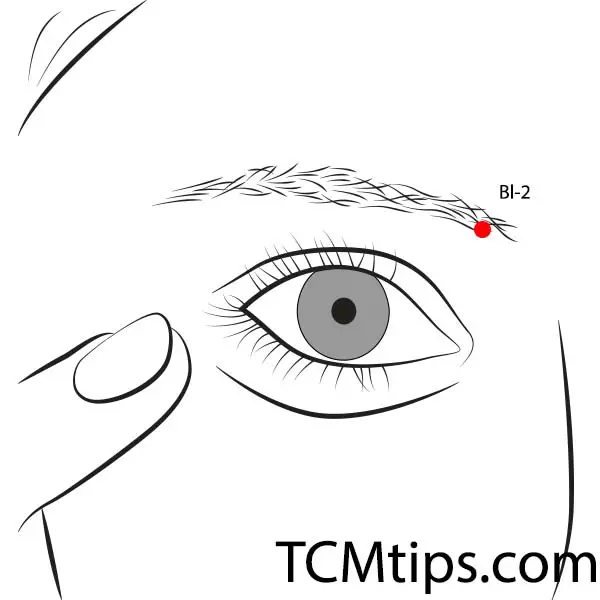
Bl-2 Zanzhu can be found right above and parallel to Jingming, in the middle of the inner corners of both eyebrows. The stimulation of this acupoint benefits the eyes as well as the head in general. Zanzhu is connected to the divergent meridian of the Bladder channel, and the stimulation of this acupoint benefits the Kidneys and sexual organs as well. This is one of the acupoints used in acupressure for better vision treatment.
Bl-2 is also included in the used acupressure points for eye floaters.
For Lateral rectus muscle paralysis
Acupoint: EM-5 (Other Names: Tai Yang)
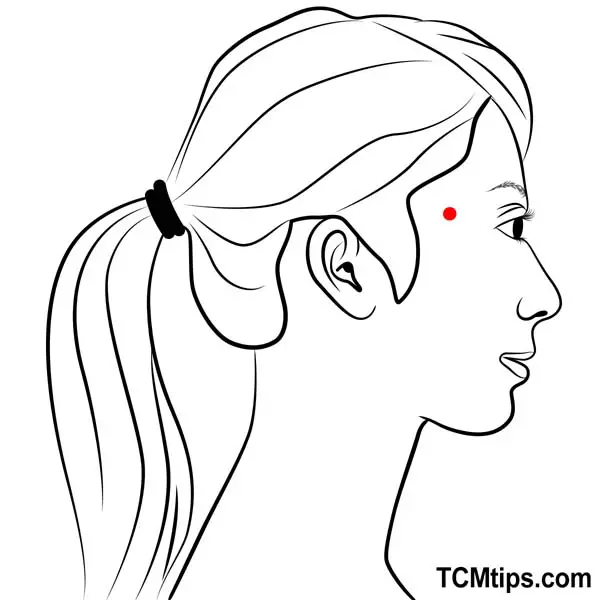
Taiyang, as this point is also called, is located on the mid-point on the side of your face between the end of your eyebrow and the start of your ear. The stimulation of this acupoint clears Heat, reduces swellings, opens the channel, and alleviates pain. This point is used in acupuncture for eye bags as well.
Find out EM-5 other uses in our article on acupressure points on the face for glowing skin.
Acupoint: GB-1 (Other Names: Gallbladder-1/Tong Zi Liao/Pupil Crevice)
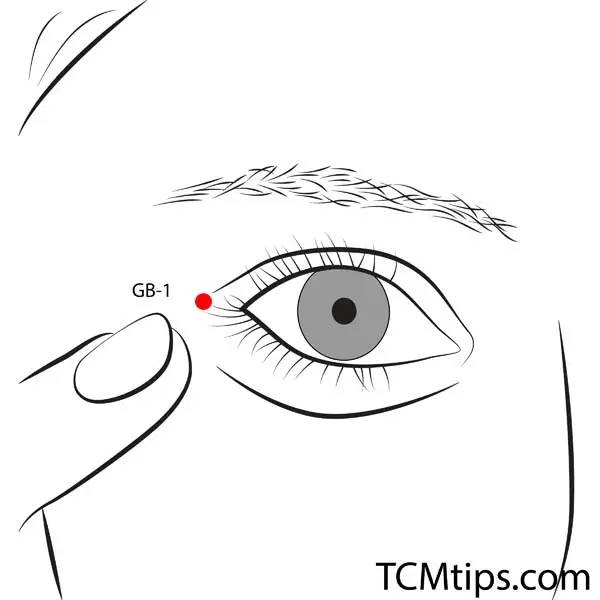
GB-1 Tongziliao is located on the external corner of the eyes, approximately one centimeter from it. The stimulation of this acupoint improves blood circulation and nerve function. See this acupoint in acupuncture for puffy eyes treatment.
Tongziliao is one of the acupressure points for dry skin as well.
For Paralysis of the Superior Rectus Muscle
Acupoint: GB-14 (Other Names: Gallbladder-14/Yang Bai/Yang White)
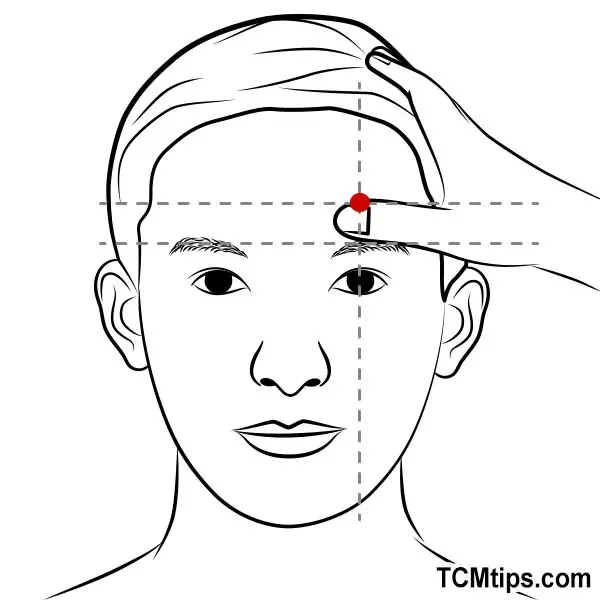
GB-14 Yangbai can be found at about one centimeter and a half above the eyebrows, parallel to the pupils of the eyes. This acupoint is beneficial to the eyes in general, and it is also helpful to relieve pain in the eyes as well as frontal headaches. This is one of the acupressure points for watery eyes.
Yangbai is also one of the acupressure points for seborrheic dermatitis.
For Inferior rectus muscle palsy
Acupoint: EM-6 (Other Names: Qiu Hou)
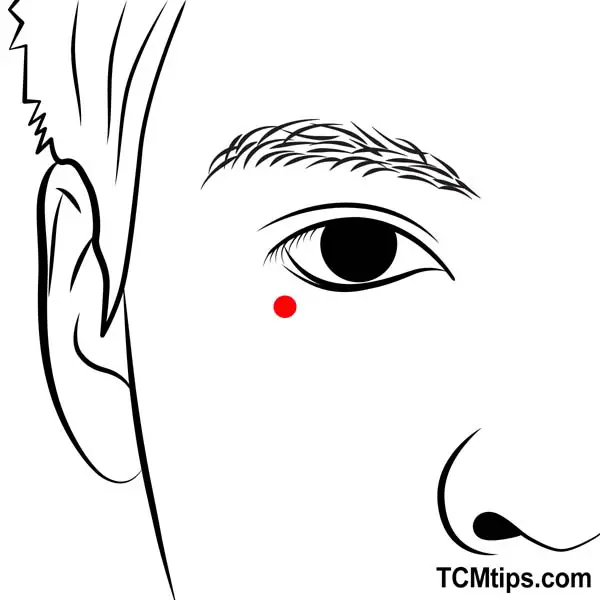
EM-6 Qiuhou can be found on the lower border of the orbit, just a finger-width from the edge of the eyes. This acupoint is effective in treating eye diseases in general, such as pigmentary degeneration of the retina, optic neuritis, early-stage cataract, and glaucoma. It’s also one of the normally used acupressure points for an eye infection and is utilized in glaucoma acupuncture treatment.
For more uses of EM-6, see acupressure points for dark circles.
Acupressure can be safely done by anyone who wishes to have a subtler treatment that is efficient. The stimulation of all these acupressure points for double vision provides a synergy that is bigger than the sum of each one. That is why it’s way more interesting to treat all those acupuncture points to improve vision instead of picking one or two only.
Another good alternative if you’re looking to restore your vision with acupuncture is to take a step further and get a full acupuncture treatment from a TCM doctor in a clinic. There are some studies that show its benefits, including this case report from a 58-year-old man with unilateral abducens palsy related to diabetes mellitus and hypertension, that I encourage you to have a look at and take your own conclusions.

Try our Anti-Aging Gua Sha Tool designed to bring out your skin’s natural glow.
Best Gua Sha Product- Anti-Aging: The tool is designed to target 11 specific aging signs such as wrinkles and sagging skin. By following the 7-step routine, users can improve skin firmness and reduce fine lines naturally.
- Enhances Skincare Routine: It works effectively with serums and lotions, boosting absorption and efficacy of skincare products.
- Visible Skin Improvement: Users can expect a smoother complexion, reduced puffiness, and a more youthful appearance.
 P. Sze
P. Sze 

